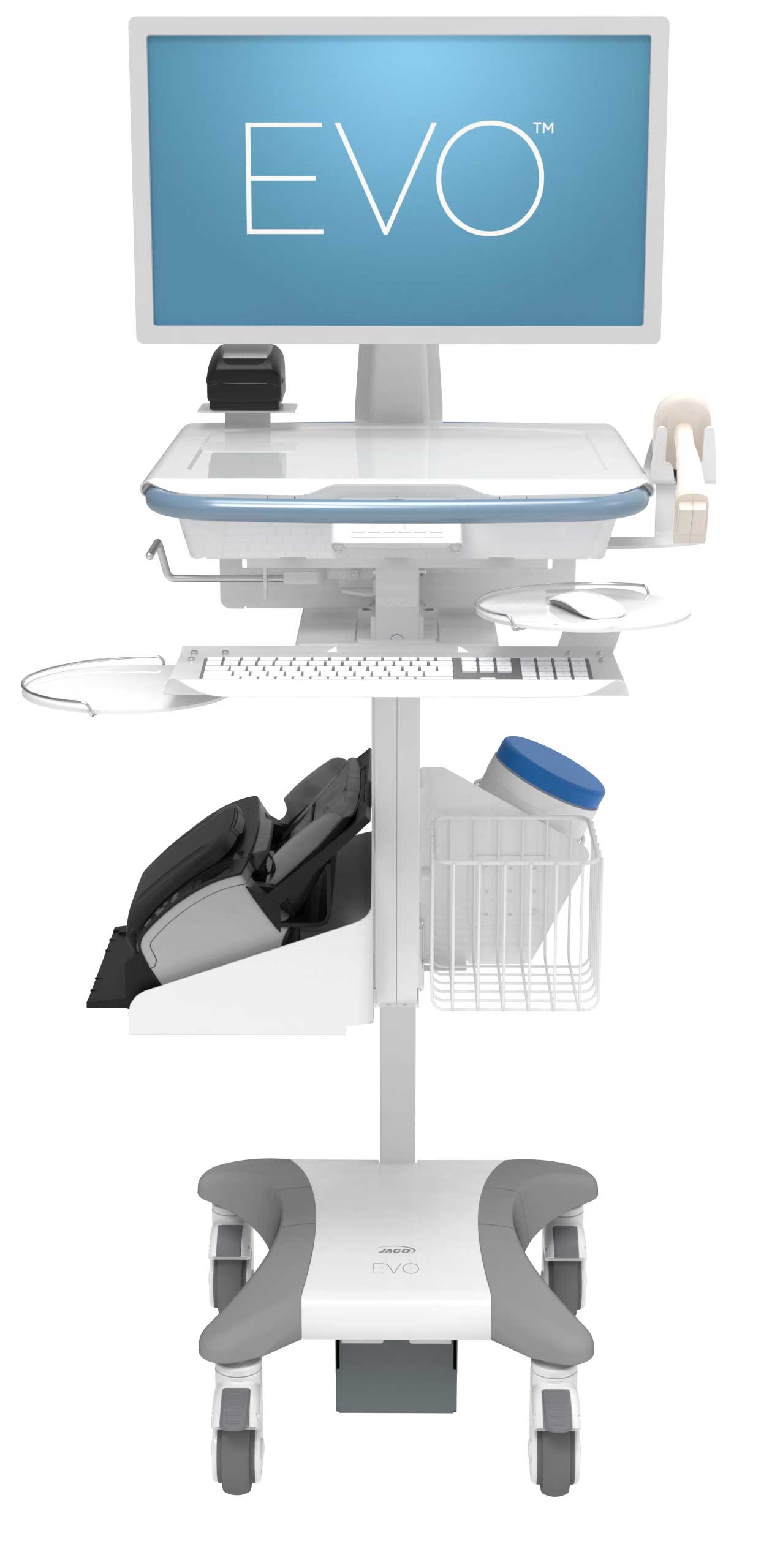If you’re a chief nursing officer or nurse manager participating in the decision to choose mobile workstations for your nurses, you’ve probably asked the question:
What do nurses want in a WOW?
Nurses have been using mobile workstations for over two decades at the bedside—completing point-of-care (POC) documentation, using electronic health records (EHR) applications, performing bedside medication verification (BMV). So there should be plenty of research available about the most important features nurses want in a WOW.
Except there isn’t. Try searching the web using any keywords you like. You’ll find some articles from manufacturers like us who make mobile workstations, but very few peer-reviewed research articles on the topic. And the ones that do exist are brief and often lacking in detail.
Why? The answer is simple: There has never been an independent, far-reaching, comprehensive study of what nurses want, and don’t want, in a workstation on wheels.
So here are some things nurses have told us they’ve learned are important to them, after years of pushing WOWs around the hospital floor for hours every shift, caring for patients.
1. A cart that’s light, easy to move, and quiet
Not surprisingly, nurses want a workstation on wheels that they can maneuver comfortably, safely and quietly at the bedside where they care for patients.
In one study, “Nursing staff…identified several negative features of WOWs: lack of stability and difficulty in maneuvering…noise, unstable cart wheels, large footprint that made ‘it impossible to walk beside…’”
Patients sleep poorly in hospital as it is due to pain, anxiety, an unfamiliar environment, and many other reasons. Excess noise in a hospital environment can interfere with patient rest and recovery. So it’s important to provide a calm, quiet environment for patients whenever possible which includes reducing unnecessary noise from mobile workstations.
2. “Goldilocks” size—a cart that’s just right
It’s also important that WOWs are small enough to move into cramped patient rooms—past curtains and overbed tables and visitor chairs, at a safe distance from sensitive medical equipment such as IV machines and special monitors and chest tube drains.
Still, there’s such a thing as too small. In a recent study, nurses indicated that some WOWs are too small to meet all the functions they need them to perform. So it’s important to identify the WOW size that is “just right” for the healthcare environment your nurses work in—neither too large nor too small to be useful.
3. Sound design and functionality
It’s critical that WOWs work for nurses at the bedside— and provide the tools and design features nurses need to have on hand to complete patient care tasks.
But it’s less about bells and whistles, and more about fundamentally sound design and functionality.
Nurses want comfortable handles for rolling and maneuvering the cart. Because losing a pen is one of the most-mentioned nurse pet peeves, an easy-to-reach cup for holding pens and similar objects is indispensable. So are easy-to-access baskets and drawers for holding other equipment and supplies nurses need—thermometers, oxygen saturation monitors, stethoscopes, worksheets, dressing supplies, etc.—as they move from room to room.
If the WOW will be used for medication administration, it needs to have an adequately sized, properly designed worksurface—with containment edges. Things happen during medication administration—pills roll as they’re released from containers; liquid medications get spilled. The last thing a nurse needs is to have a pill roll off the worksurface and become contaminated, so it needs to be replaced by pharmacy—and delivered late to the patient. Or to have to clean a liquid mess off the floor before a patient or visitor slips on it.
4. Excellent ergonomics
Mobile workstations have plenty of room for improvement when it comes to ergonomic design. Common requests from nurses include:
- No bending. Nurses don’t want to have to bend awkwardly when reaching into drawers or baskets, or when locking the cart wheels.
- Easy height adjustment. Nurses want to be able to adjust the worksurface to a comfortable height for standing or sitting and make tiny adjustments until the height is just right—all with minimal exertion and effort. (Surprisingly, an electronic powered lift is not always the answer. See ‘Know your priorities—and avoid feature conflicts and tradeoffs,’ below.)
- Keyboard and mouse comfort. It’s not enough for a keyboard tray to be adjustable—it needs to allow negative tilt (down and away from the nurse) to promote a healthy wrist posture and prevent carpal tunnel syndrome. The cart should also allow or provide a mouse surface raised higher than the keyboard level, to prevent unhealthy shoulder, arm, and wrist postures (and to prevent nurses from mousing on the cart worksurface, which isn’t hygienic).
5. Easy cleaning—and state-of-the-art infection control
Infection control is always top of mind for nurses and for nurse leadership. Mobile workstations need to be quick and easy to clean when needed. WOW surfaces need to be non-porous and able to withstand frequent exposure to EPA-registered disinfectant solutions such as glutaraldehyde, glutaraldehyde with phenol/phenate, ortho-phthalaldehyde, hydrogen peroxide, and both hydrogen peroxide and peracetic acid—all without peeling, cracking, warping or staining.
As more and more hospitals make significant investments in room-cleaning ultraviolet (UV) sterilization technology, they should consider WOWs that can withstand regular exposure to UV-C radiation. Here, carts with metal surfaces have a distinct advantage. UV-C radiation can cause certain plastics to ‘chalk’ and degrade over time; some hospitals have reported WOW surfaces starting to melt and warp after just a few UV cleaning exposures.
6. Dependable power
There’s nothing more frustrating for a busy nurse than having to spend precious time hunting down a WOW, only to find one on which another nurse has put a sticky note that says “Doesn’t work” or “Needs charging”.
The saying “Time is money” holds true, especially in hospitals where nursing salaries make up one of the largest budget items. Research has shown that a nurse spends approximately 208 hours a year looking for equipment. And that’s just one nurse! Multiply that by the number of nurses on your unit and you’ll see the wasted hours (and money) spent looking for equipment.
Another issue nurses have identified: Power cords on WOWs should be long enough to reach outlets for recharging. They also need to be easily stored out of the way on the workstation when it isn’t being charged so they aren’t a tripping hazard.
Keep in mind that multiple workstations are often stored in the same location for recharging which means not all WOWs can be located close to an electrical outlet. In addition, areas for recharging equipment are also often occupied by other equipment that needs recharging such as IV machines, tube feed machines, vital sign machines, etc.
7. Intuitive ease of use
Nurses work with a variety of patient care equipment throughout their shift. To reduce nursing frustration and time wasted trying to figure out how a piece of equipment works, workstations should be as simple and intuitive to use as possible. This goes for the EHR system on top of the mobile workstation as well.
In a recent study, nurses gave EHR usability a grade of ‘F’ and researchers found that poor EHR usability was associated with higher rates of nurse burnout. Because nurses spend 26.2% to 41% of their time performing documentation, it’s critical that this work be as easy as possible for nurses to complete. EHR systems and mobile workstations that are easy to use reduce nursing frustration and nurse burnout and allow nurses to spend more time providing high quality patient care.
When it comes to the ease of using a WOW, some important questions to consider include:
- Is the WOW interface difficult, confusing, time-consuming, or even necessary to learn?
- Does the arrangement of devices and tools on the WOW such as printers, scanners, and storage require nurses to move around a lot to access these components or take their eyes off the EHR at key moments while referencing or entering data or communicating with the patient?
8. Unobstructed patient engagement
The most important reasons for purchasing WOWs is to enable nurses to take the EHR to the bedside and engage with their patients. So it’s important to choose a WOW that makes this engagement easier, not more difficult.
Some WOW features mentioned above—compact footprint, easy maneuverability—can help nurses position the cart optimally, no matter how crowded the patient room might be. A low-profile base that slides under the patient bed can help the nurse bring the cart closer to the patient. A wide LCD and keyboard pivot range is another big advantage.
Establishing a “triangle of trust,” where the patient and physician can see each other as well as the EHR screen, has become a best practice identified by research for improving communication between physicians and patients. Nurses should be educated about the importance of establishing this “triangle of trust” with their patients to improve communication—and the WOWs they use should allow them to do so.
Besides providing point-of-care (POC) documentation which helps reduce errors, nurses are also able to use the EHR at the bedside to answer patients’ questions about their medical care. Having the EHR at the bedside also provides an opportunity for nurses to complete patient teaching in a timely way when patients have questions. Being able to respond to patient questions with the EHR present provides real-time opportunities for patient education when the patient is most eager to learn. This can save valuable time when the nurse is able to perform patient teaching and document it in the moment without having to return and perform teaching later.
9. Flexibility to adapt as workflows change
Workflow requirements often change in ways that neither nurses nor IT staff can anticipate. Departments can quickly find themselves requiring carts with longer runtimes, more storage, or support for the latest equipment and technologies—e.g., cameras for telemedicine or remote patient monitoring, document scanners for ‘no-touch’ data collection.
So in addition to choosing carts best equipped to meet their current needs, nurse managers increasingly want carts that can easily adapt as needs change. A cart with easily swappable mounts for a wide range of medical devices and computer peripherals can help ensure that nurses won’t be forced to ‘make do’ at the bedside until the next WOW purchasing cycle. And cart platforms offering scalable power—enabling quick and inexpensive power upgrades or non-powered-to-powered conversion—are becoming increasingly popular with nurses, IT and hospital management.
10. A good investment by nursing leadership
Nurse managers have several different criteria they’re looking for when deciding what equipment to purchase. Nurse managers and nurse leaders need to demonstrate to those they report to that the equipment they buy is a good investment decision, over both the short and long term.
This means selecting equipment that’s reliable, functional, safe, and has minimal maintenance costs. Maintenance equals equipment downtime. This means more money spent in addition to the initial purchase price. It also means nursing staff has to work without this equipment or look for replacement equipment (see point #6 above re: hours of nursing time wasted).
This results in frustrated nurses who resent that they don’t have the equipment they need to do their job. Hence, nurse managers are looking for equipment that makes the work of nursing staff faster, easier, and safer so patients receive high-quality care they’re happy with.
Nursing recruitment and retention and nursing engagement are always key priorities for nursing leadership as well. When nursing leadership is able to improve nursing job satisfaction by ensuring nurses have the equipment they need to do their jobs effectively, quality of patient care increases and they’re able to retain and attract highly qualified nurses.
As Dempsey & Reilly point out, “Preventive maintenance (of equipment) and a proactive approach to capital management will have a much better return on investment than the lost productivity and potential turnover costs associated with the frustration and lack of engagement that insufficient (equipment) beget.”
Selecting the right workstation on wheels that meets the needs of your staff and your budget doesn’t have to be difficult. But it does mean giving some serious thought to what you’re getting for your money over the long run. And the first step in this process is to start by asking your nurses what they need to do their job.
Know your priorities—and avoid feature conflicts and tradeoffs
Not all features on a mobile workstation are equally important—or equally beneficial—to nurses using the workstations, or to the hospital that’s paying for them. And in some cases, cart features that meet one nurse requirement can prevent the cart from satisfying others.
For example, powered lift offers the tempting benefit of push-button height adjustment, and sometimes even programmable height adjustment that stores different users height settings in memory.
It sounds like a no-brainer—until you consider that powered lift
- can add 20 to 40 lbs. to the overall weight of the cart;
- takes a long time to adjust, so that nurses often choose to work at an uncomfortable height rather than wait for the motorized adjustment;
- makes mechanical noise—again, so that nurses often choose to work in discomfort rather than risk waking or disturbing the patient;
- has more potential failure points than mechanical height adjustments, increasing the risk of more downtime, more IT time spent repairing WOWs, and higher repair costs.
The moral of the story: Stick to your priorities and do your research.
Do your due diligence—go beyond comparing feature lists, and make sure to compare how features and capabilities are implemented. Do they impact the workstation’s size, weight or power consumption? Do they get between your nurses and their work—or their patients? Do they require nurses or IT staff to learn new software? Do they require regular maintenance? What is their track record for reliability? Are they covered under the cart’s standard support coverage and warranty? How much downtime is required to fix the feature when it fails, and what is the repair cost?
Answer these questions before you make a workstation purchase your nurses, IT staff and hospital will regret.

Leona Werezak MN, BSN, RN is a freelance nurse writer. She has worked as a nurse in a variety of positions at the bedside for 13 years and as a nurse manager. From there, she began teaching nursing in BSN programs for the next 20 years. As a freelance nurse writer, she now writes online content for healthcare and medical businesses, nursing schools and colleges, as well as various nursing sites.





